External links
| This article about an Iranian politician is a stub. You can help Wikipedia by expanding it. |
Kamal Daneshyar is a member of the Islamic Consultative Assembly in the Islamic Republic of Iran.
Daneshyar has expressed support for private U.S. and European companies to assist Iran in the development of power plants for peaceful use of nuclear energy. [1]
| This article about an Iranian politician is a stub. You can help Wikipedia by expanding it. |

Bushehr or Bushire, also known as Bandar Bushehr, previously Beh Ardasher, Antiochia in Persis and Bukht Ardashir, is the capital city of Bushehr Province, Iran. At the 2006 census, its population was 161,674, in 40,771 families.
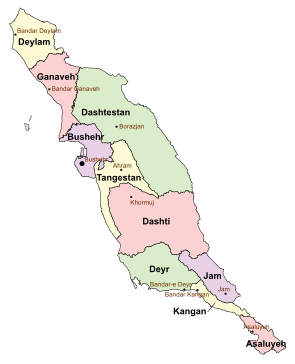
Bushehr Province is one of the 31 provinces of Iran. It is in the south of the country, with a long coastline onto the Persian Gulf. Its center is Bushehr, the provincial capital. The province has ten counties: Asaluyeh, Bushehr, Dashtestan, Dashti, Deyr, Deylam, Jam, Kangan, Ganaveh and Tangestan. In 2011, the province had a population of approximately 1 million people.
The nuclear program of Iran has included several research sites, two uranium mines, a research reactor, and uranium processing facilities that include three known uranium enrichment plants. In 1970, Iran ratified the Non-Proliferation Treaty (NPT), making its nuclear program subject to the IAEA's verification.

Natanz is a city and capital of Natanz County, Isfahan Province, Iran. At the 2006 census, its population was 12,060, in 3,411 families. It is located 70 kilometres (43 mi) south-east of Kashan.

Iran is not known to currently possess weapons of mass destruction (WMD) and has signed treaties repudiating the possession of WMDs including the Biological Weapons Convention, the Chemical Weapons Convention, and the Non-Proliferation Treaty (NPT). Iran has first-hand knowledge of WMD effects—over 100,000 Iranian troops and civilians were victims of chemical weapons during the 1980s Iran–Iraq War.

Iranian–Israeli relations can be divided into four major phases: the period from 1947–53, the friendly period during the era of the Pahlavi dynasty, the worsening period from the 1979 Iranian Revolution to 1990, and finally the hostility since the end of the First Gulf War. In 1947, Iran was among 13 countries that voted against the UN Partition Plan for Palestine. Two years later, Iran also voted against Israel's admission to the United Nations.

The maritime fleet of the Islamic Republic of Iran Shipping Lines comprises 115 ocean-going vessels, with the total capacity of 3.3 million tons deadweight (DWT). The ownership structure of the fleet comprises 87 ocean-going vessels in IRISL and 28 different types of ships under the flag of subsidiaries, including Khazar Shipping, Valfajr as well as Iran-India Shipping Companies. They are manned by 6,000 Iranian personnel including shore staff, deck and engine officers as well as ratings, who work under the flag of the Islamic Republic of Iran in the Caspian Sea, Persian Gulf, international waters and various ports of the world.
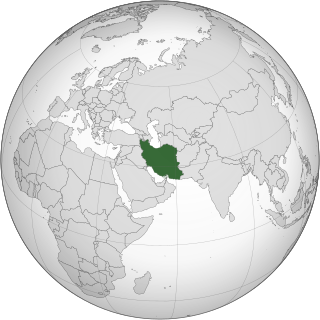
United Nations Security Council Resolution 1747 was a United Nations Security Council resolution that tightened the sanctions imposed on Iran in connection with the Iranian nuclear program. It was adopted unanimously by the United Nations Security Council on 24 March 2007.
This is the timeline of the nuclear program of Iran.
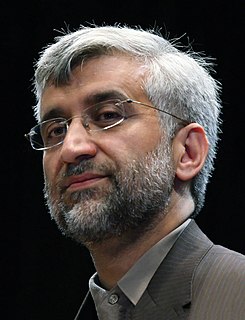
Saeed Jalili is an Iranian conservative politician and diplomat who was secretary of the Supreme National Security Council from 2007 to 2013. He was also Iran's nuclear negotiator. He was previously deputy foreign minister for European and American Affairs. Jalili was an unsuccessful candidate in the June 2013 presidential election, placing third.
Iran's nuclear program is made up of a number of nuclear facilities, including nuclear reactors and various nuclear fuel cycle facilities.
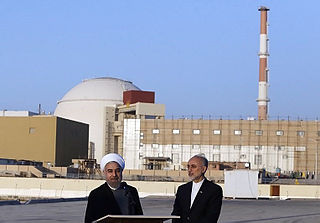
The Bushehr Nuclear Power Plant is a nuclear power plant in Iran 17 kilometres (11 mi) southeast of the city of Bushehr, between the fishing villages of Halileh and Bandargeh along the Persian Gulf.

IR-40 also known as Arak Nuclear Plant is an Iranian 40 megawatt (thermal) heavy water reactor under construction near Arak, adjacent to the 1990s era Arak Heavy Water Production Plant. Civil works for the construction began in October 2004. It was initially planned that the reactor would begin nuclear operations in 2014.
The Darkhovin Nuclear Power Plant is a planned nuclear power plant located about 70 kilometers south of Ahvaz, Iran at the Karun river, as part of the nuclear program of Iran. One reactor is firmly planned. Some other projects on this site were cancelled.
Events in the year 2010 in the Islamic Republic of Iran.

Fordo or Fordow is a village in Fordo Rural District, Kahak District, Qom County, Qom Province, Iran. It is located near the Shia holy city of Qom. At the 2006 census, its population was 732, in 230 families.
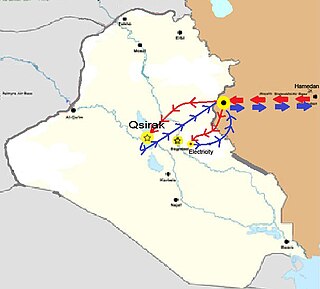
Operation Scorch Sword was a surprise airstrike carried out by Islamic Republic of Iran Air Force (IRIAF) on 30 September 1980, that damaged an almost-complete nuclear reactor 17 km south-east of Baghdad, Iraq. Eight days into the Iran–Iraq War, Operation Scorch Sword commenced. At dawn on 30 September 1980, four Iranian F-4E Phantom jets refueled mid-air near the Iran-Iraq border. After crossing into Iraq, the fighters climbed to a higher altitude to be undetectable by Iraqi radar. Moments later, two of the Phantoms peeled off, and dropped to a lower altitude again to avoid radar detection. They flew stealthily to Tuwaitha, a city ten miles (17.58 km) southeast of Baghdad, home to the Osirak nuclear reactor.
Nuclear Power Plant, Bushehr is a village and company town in Howmeh Rural District, in the Central District of Bushehr County, Bushehr Province, Iran. At the 2006 census, its population was 3,341, in 921 families.
Fordow Fuel Enrichment Plant (FFEP) is an Iranian underground uranium enrichment facility located 20 miles (32 km) northeast of the Iranian city of Qom, near Fordow village, at a former Islamic Revolutionary Guard Corps base. The site is under the control of the Atomic Energy Organization of Iran (AEOI). It is the second Iranian uranium enrichment facility, the other one being that of Natanz. According to the Institute for Science and International Security, possible coordinates of the facility's location are: 34.88459°N 50.99596°E
Development and Justice Party of Islamic Iran or Islamic Iran Development and Justice Party is a conservative political party in Iran, with a claimed goal of "increasing public participation in politics".